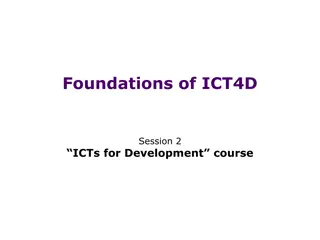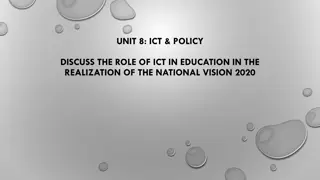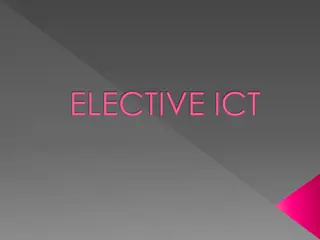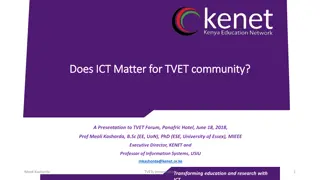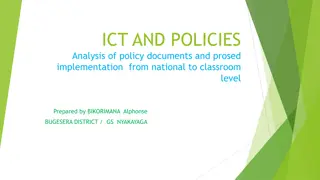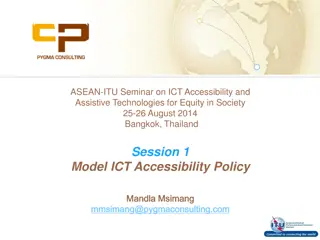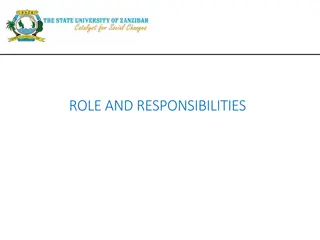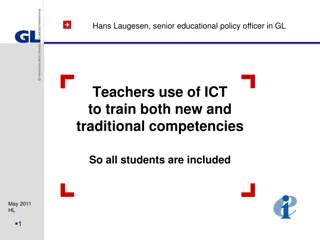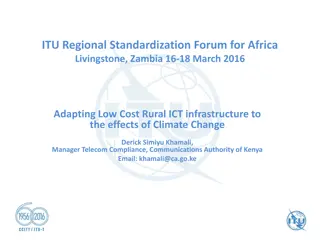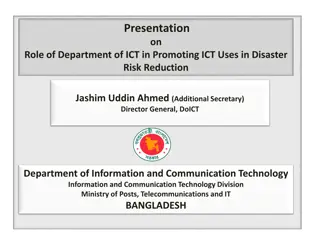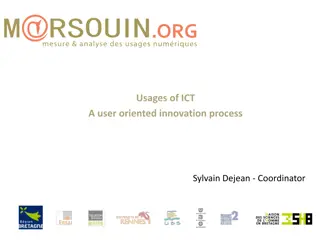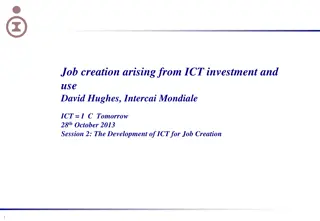
Key Factors and Stakeholders in ICT Decisions within Schools
Exploring the key factors and stakeholders involved in making crucial ICT decisions in educational settings. Understanding the significance of budget considerations, equitable access, and classroom conditions for successful technology integration. Emphasizing the importance of utilizing existing technologies effectively before investing in new ones.
Download Presentation

Please find below an Image/Link to download the presentation.
The content on the website is provided AS IS for your information and personal use only. It may not be sold, licensed, or shared on other websites without obtaining consent from the author. If you encounter any issues during the download, it is possible that the publisher has removed the file from their server.
You are allowed to download the files provided on this website for personal or commercial use, subject to the condition that they are used lawfully. All files are the property of their respective owners.
The content on the website is provided AS IS for your information and personal use only. It may not be sold, licensed, or shared on other websites without obtaining consent from the author.
E N D
Presentation Transcript
DIGITAL PEDAGOGY.. DIGITAL PEDAGOGY
QUESTION: WHAT ARE THE KEY FACTORS AND WHO ARE THE STAKEHOLDERS AND THEIR ROLES IN MAKING KEY ICT DECISIONS IN SCHOOLS.
INTRODUCTION The question is two sided where by the first part which is (FACTORS TO BE CONSIDERED WHEN MAKING ICT DECISIONS IN SCHOOLS) .is explained below. Stakeholders are people or groups who are actively involved in the project, or whose life or work will in some way be influenced by the project. Stakeholders can be individuals, institutions, organisations or groups. Stakeholders can be directly involved in the activity (for example, teachers, officials, students) or can simply be affected by it (for example, parents, employers, textbook publishers).The considered stakeholders in a school setting include Director, Head teacher, teachers, students,parents among others. The factors to be considered are explained below
The best technology is the one you already have, know how to use, and can affordThe introduction of a new technology is considered on its own to be 'innovative' in many circumstances. Parachuting in the 'latest and greatest' device or gadget may have strong political appeal, and fatten the bottom lines of certain firms, and may possibly even be effective in some cases, but instead of instinctively trying to 'innovate' using new technologies, which bring with them lots of challenges, it may be useful to ask, How can we innovate using what we already have? In poor, rural, isolated communities, the technologies already at hand are almost always mobile phones and radios. Before considering the latest and great new gadget, why not see what quick gains might be made by utilizing technologies which already exist (and are being used, and sustained) in such communities?
BUDGET CONSIDERATIONSConsider your funding sources and their availability. A one-time allocation of funds requires the selection of technology with a long lifespan. But technology can be replaced more often if funds are available on a recurring basis. Don t forget to budget for professional development, technology support, infrastructure, retrofitting classrooms and installations. EQUITABLE ACCESSAll students, staff and leaders must have robust and reliable access to current and emerging technologies and digital resources. Universal access can be achieved with an infrastructure that brings connectivity to all learning spaces, or by equipping all learning spaces with document cameras and projectors. CLASSROOM CONDITIONSConsider the technology capacity of your classrooms. For a 1-to-4 computer- student ratio or a notebook initiative, make sure there is enough real estate and electrical capacity in the classroom. Also, check the location of electrical outlets; if computers are crowded along a single wall, students won t have room to work in small groups.If you are considering projectors and document cameras or interactive whiteboards, how will you arrange the cables so students don t trip? Is there room on the front wall for an interactive whiteboard? These issues require that thought be given to the impact on instructional classroom best practices, varied teaching styles, traffic patterns and safety in addition to budgetary considerations
SUSTAINABILITY . Without a large grant or technology levy, sustainability may be the prevailing factor when selecting classroom technologies. The following is a list of indicators for sustainability:Broad in scope: Sustainable technology can be used for student learning, professional development, board presentations, and PTA and community meetings.Applicable to most subject areas: Technology that can be used for instruction across the curriculum reduces the need for specialized training and support.Easy to use: Teachers will embrace technology that is easy to connect, turn on and use right out of the box.Easy to integrate: Teachers don t have a lot of time to create high-end, professional- quality lessons. The best technologies are those that teachers can use to trans- form old lessons into visually rich activities that yield high-end results.Minimal training and support: Setup, training and an- nual support should require less than an hour, and the technology should be easy for teachers to troubleshoot. NUMBER OF STUDENTS. The number of students is another factor to be considered when taking ict decisions in a school setting .How many students in a school are willing to take on computers as a subject and how many have the possibility to attend online digital learning such that smooth learning can take place which makes it easier for the policy makers to easily make ict decisions in a school setting.
AVAILABILITY OF COMPUTER LABORATORIES IN SCHOOLS .It is another factor that should be considered when making ict decisions in a school setting. As policy makers think of putting in place some affirmations like digital learning and teaching, they should consider the availability of computer laboratories and its requirements for example stable working computers and the high number of them to be used in the classroom by students. ECONOMIC FACTOR .It is one factor that should be considered while making key decisions in ICT. We should keep asking questions about the economic situation of the schools. For example Is the school in position to install WIFI where by learners are able to make some research using that free internet .
Start down and out, and then move up and in . What types of educational technology projects are most likely to scale -- those that are piloted in relatively 'privileged' environments until they 'work', and then expanded to reach other, less advantaged communities, or projects that take the opposite approach? If it (the technology, the model, the approach) works in a privileged environment, success may be a product of a number of factors that that don't apply in other, less advantaged places. If you want to go to scale with your educational technology initiative, first start down and out before you move up and in. Your learning curve will be steeper in the short run. The 'model' you end up with may have more modest goals when compared with what can be achieved in some of the most privileged and advantaged schools and communities. But it just might work *everywhere*. Or, if not everywhere, at least it might work in a lot more places than if you had started 'up and in', and then tried to move 'down and out'.
Treat teachers like the problem and they will beOver the years I have talked with lots of people who see teachers (and teachers' unions) as a 'problem' that needs to be 'solved'. One 'solution' increasingly considered is to figure out ways to use ICTs as a sort of metaphorical stick with which to prod teachers into various sorts of actions. This impulse is perhaps understandable in places that suffer endemic challenges related to (for example) teacher absenteeism, which is certainly a very serious problem in certain (often poor, rural) communities. That said, it may not be all that productive at a practical level STUDENT ACHIEVEMENT GOALSYour school improvement plan is fundamental to the selection of classroom technology. There are some great solutions for improving performance and achieving outcomes. For example, graphing calculators and probeware can visually enrich lessons and provide immediate feedback in math and science courses, and teachers of reading can use document cameras, interactive whiteboards, software and websites for improving literacy skills. LOCATION It is another factor that should be considered when making ICT decisions in a school setting. Considering network possibilities and transport of the materials used in digital learning and teaching. One can keep asking themselves the following questions .ls the location of the school easily accessible ? , ls the network stable .Before policy makers consider implementations ,they should look at the explained points to make digital learning and teaching a success.
The second part of the question which is (WHO ARE THE STAKEHOLDERS AND THEIR ROLES WHILE TAKING ICT DECISIONS IN SCHOOLS.)is explained below. INTRODUCTION Stakeholders are people or groups who are actively involved in the project, or whose life or work will in some way be influenced by the project. Stakeholders can be individuals, institutions, organisations or groups. Stakeholders can be directly involved in the activity (for example, teachers, officials, students) or can simply be affected by it (for example, parents, employers, textbook publishers). Stakeholders are : teachers, students , parents, community personnels, business people, donors, board members and Ministry of Education.
School boards - deal with governance of the school. They are the guardians of the policy that help implement changes that will benefit the region or support the principal who has the responsibility of implementing and maintaining the policies set by the board especially the implementations of ICT decisions as presented to the Principal by the DOS heading the school board . According to Darden (2008), the school board has to take in legal considerations when making decisions pertaining to policy governing them (Waters 2011).
Teachers- The teacher especially ICT teacher , along with the student, plays an interactive role in the education process because one cannot function without the other. "The empowerment of teachers will facilitate the empowerment of students (Short and Greer, 2002)." Teacher empowerment takes the form of providing teachers with a significant role in decisions making, control over their work environment and conditions, and opportunities to serve in a range of professional roles (Short and Greer, 2002). The teacher as a stakeholder is expected to possess the professional knowledge to lead the students in instruction. In addition to serving in an instructional role the teacher can be a mentor, supervisor, counselor, and community leader. The teacher can be a mentor to students or other teachers. The role of supervisor is present in every aspect of a teacher's daily responsibilities. The teacher's role as counselor can be used to offer advice to students or school advisory committees (waters 2011).
Students- The student plays the lead role in the educational process and as stakeholders are expected to participate in the process. Although the student's primary role is that of a recipient, students should be encouraged to exercise their decision-making role in the education process. By giving aid to the decision-making process students become an integral part of a successful institution. As a result of their participation students gain the skills and knowledge needed to be productive and viable part of our society. Students as stakeholders possess both intrinsic and extrinsic motivational factors. The intrinsic motivation comes with understanding the value of an education. Extrinsic motivations are the accolades students receive for successful completing their education (waters 2011). Parents.- Parents play key roles as educational stakeholders. Parents' primary objective is the assurance that their children will receive a quality education, which will enable the children to lead productive rewarding lives as adults in a global society. Parents as educational stakeholders provide additional resources for the school to assist with student achievement and to enhance a sense of community pride and commitment, which may be influential in the overall success of the school during the ICT decisions and implementations (Water 2011).
Ministry of Education: sets the strategic direction of the school, collaborate with schools to formulate effective policies and practices, works in tandem with schools to inform and clarify policy positions to the public, and Supports teachers in helping their students achieve the Desired Outcomes of Education and Collaborates with other government agencies and non-governmental organizations to formulate effective programmes and practices. Community : up holds and transmits the right values and attitudes to our young, recognizes the variety of abilities and talents displayed by our young and sees the worth in each child, offers scholarships and bursaries to students and teachers, provides support to families and students who are in need of assistance (stakeholders in Education 2013) Business communityProvides opportunities for the young to experience the world of work, Collaborates with schools to formulate effective programmes for the young such as offering work related projects, Supports placement opportunities for the professional development of teachers, and offers scholarships and bursaries to students and teachers (stakeholders in Education 2013). Donors These are business people, agencies and institutions that give support to schools in cash or kinds
Reference: Waters, E., (2011) The roles of educational stakeholders and influencing factors Retrieved from http://voices.yahoo.com/the- roles-educational-stakeholders-influencing- 10343743.htmlStakeholders in Education (2014) Retrieve from http://www.moe.gov.sg/compass/resources/stakeholders-in- education/
Pictures showing stakeholders in schools


